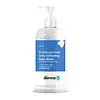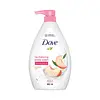What's inside
What's inside
 Key Ingredients
Key Ingredients

 Benefits
Benefits

 Concerns
Concerns

 Ingredients Side-by-side
Ingredients Side-by-side

Water
Skin ConditioningDisodium Laureth Sulfosuccinate
CleansingCocamidopropyl Betaine
CleansingGlycerin
HumectantCaprylyl/Capryl Glucoside
CleansingSodium Methyl Cocoyl Taurate
CleansingCoco-Glucoside
CleansingLauryl Glucoside
CleansingCocamide DEA
EmulsifyingSalicylic Acid
MaskingGlycolic Acid
BufferingSodium Lauroyl Oat Amino Acids
CleansingZinc
AntioxidantPCA
HumectantSaccharide Isomerate
HumectantOlive Oil PEG-7 Esters
EmollientBetaine
HumectantImidazolidinyl Urea
PreservativeMenthol
MaskingMelaleuca Alternifolia Leaf Oil
AntioxidantPolyquaternium-7
Propylene Glycol
HumectantPEG-150 Distearate
EmulsifyingDisodium EDTA
Methylchloroisothiazolinone
PreservativeMethylisothiazolinone
PreservativeWater, Disodium Laureth Sulfosuccinate, Cocamidopropyl Betaine, Glycerin, Caprylyl/Capryl Glucoside, Sodium Methyl Cocoyl Taurate, Coco-Glucoside, Lauryl Glucoside, Cocamide DEA, Salicylic Acid, Glycolic Acid, Sodium Lauroyl Oat Amino Acids, Zinc, PCA, Saccharide Isomerate, Olive Oil PEG-7 Esters, Betaine, Imidazolidinyl Urea, Menthol, Melaleuca Alternifolia Leaf Oil, Polyquaternium-7, Propylene Glycol, PEG-150 Distearate, Disodium EDTA, Methylchloroisothiazolinone, Methylisothiazolinone
Water
Skin ConditioningCocamidopropyl Betaine
CleansingSodium Methyl Lauroyl Taurate
CleansingSodium Lauroyl Isethionate
CleansingParfum
MaskingGlycerin
HumectantGlycol Distearate
EmollientPhenoxyethanol
PreservativeSodium Hydroxide
BufferingSodium Chloride
MaskingLauric Acid
CleansingLaureth-4
EmulsifyingSodium Isethionate
CleansingCaprylic Acid
CleansingCapric Acid
CleansingZinc Oxide
Cosmetic ColorantSodium Methyltaurate
Skin ConditioningPalmitic Acid
EmollientStearic Acid
CleansingTetrasodium EDTA
Iodopropynyl Butylcarbamate
PreservativePPG-9
Skin ConditioningPEG-150 Pentaerythrityl Tetrastearate
EmulsifyingLactic Acid
BufferingCitric Acid
BufferingSodium Ascorbyl Phosphate
AntioxidantPrunus Persica Juice
MoisturisingPropylene Glycol
HumectantGeraniol
PerfumingLimonene
PerfumingLinalool
PerfumingCI 19140
Cosmetic ColorantCI 17200
Cosmetic ColorantWater, Cocamidopropyl Betaine, Sodium Methyl Lauroyl Taurate, Sodium Lauroyl Isethionate, Parfum, Glycerin, Glycol Distearate, Phenoxyethanol, Sodium Hydroxide, Sodium Chloride, Lauric Acid, Laureth-4, Sodium Isethionate, Caprylic Acid, Capric Acid, Zinc Oxide, Sodium Methyltaurate, Palmitic Acid, Stearic Acid, Tetrasodium EDTA, Iodopropynyl Butylcarbamate, PPG-9, PEG-150 Pentaerythrityl Tetrastearate, Lactic Acid, Citric Acid, Sodium Ascorbyl Phosphate, Prunus Persica Juice, Propylene Glycol, Geraniol, Limonene, Linalool, CI 19140, CI 17200
Ingredients Explained
These ingredients are found in both products.
Ingredients higher up in an ingredient list are typically present in a larger amount.
Cocamidopropyl Betaine is a fatty acid created by mixing similar compounds in coconut oil and dimethylaminopropylamine, a compound with two amino groups.
This ingredient is a surfactant and cleanser. It helps gather the dirt, pollutants, and other impurities in your skin to be washed away. It also helps thicken a product and make the texture more creamy.
Being created from coconut oil means Cocamidopropyl Betaine is hydrating for the skin.
While Cocamidopropyl Betaine was believed to be an allergen, a study from 2012 disproved this. It found two compounds in unpure Cocamidopropyl Betaine to be the irritants: aminoamide and 3-dimethylaminopropylamine. High-grade and pure Cocamidopropyl Betaine did not induce allergic reactions during this study.
Learn more about Cocamidopropyl BetaineGlycerin is already naturally found in your skin. It helps moisturize and protect your skin.
A study from 2016 found glycerin to be more effective as a humectant than AHAs and hyaluronic acid.
As a humectant, it helps the skin stay hydrated by pulling moisture to your skin. The low molecular weight of glycerin allows it to pull moisture into the deeper layers of your skin.
Hydrated skin improves your skin barrier; Your skin barrier helps protect against irritants and bacteria.
Glycerin has also been found to have antimicrobial and antiviral properties. Due to these properties, glycerin is often used in wound and burn treatments.
In cosmetics, glycerin is usually derived from plants such as soybean or palm. However, it can also be sourced from animals, such as tallow or animal fat.
This ingredient is organic, colorless, odorless, and non-toxic.
Glycerin is the name for this ingredient in American English. British English uses Glycerol/Glycerine.
Learn more about GlycerinPropylene Glycol is an odorless, colorless liquid. As a humectant, it helps skin retain moisture. It also aids in delivering active ingredients.
Another role of this ingredient is preventing a product from melting or freezing. Propylene glycol also adds antimicrobrial properties to a product, elongating product lifespan.
This ingredient is considered an organic alcohol and commonly added into both cosmetics and foods.
Those with sensitive skin or conditions may develop a rash when using this ingredient.
Learn more about Propylene GlycolWater. It's the most common cosmetic ingredient of all. You'll usually see it at the top of ingredient lists, meaning that it makes up the largest part of the product.
So why is it so popular? Water most often acts as a solvent - this means that it helps dissolve other ingredients into the formulation.
You'll also recognize water as that liquid we all need to stay alive. If you see this, drink a glass of water. Stay hydrated!
Learn more about Water